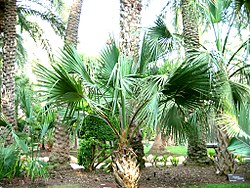Sabal bermudana: Difference between revisions
Created page with '{{SPlantbox |familia=Arecaceae |genus=Sabal |species=bermudana |common_name=Bermuda palmetto |name_ref=Flora - A Gardener's Encyclopedia |habit=palm-cycad |habit_ref=Flora - A G…' |
No edit summary |
||
| Line 1: | Line 1: | ||
{{SPlantbox | {{SPlantbox | ||
|familia=Arecaceae | |familia=Arecaceae | ||
|genus=Sabal | |genus=Sabal | ||
|species=bermudana | |species=bermudana | ||
|common_name=Bermuda palmetto | |common_name=Bermuda palmetto | ||
| Line 22: | Line 22: | ||
|usda_ref=Flora - A Gardener's Encyclopedia | |usda_ref=Flora - A Gardener's Encyclopedia | ||
|max_zone=11 | |max_zone=11 | ||
|image= | |image=Sabal-bermudana.jpg | ||
|image_width=240 | |image_width=240 | ||
}} | }} | ||
'''''Sabal bermudana''''', commonly known as the '''Bermuda Palmetto''', is one of 15 species of [[Arecaceae|palm trees]] in the genus ''[[Sabal]]'' and is endemic to [[Bermuda]]. | |||
''Sabal bermudana'' grows up to {{convert|25|m|ft|abbr=on}} in height, with the occasional old tree growing up to {{convert|30|m|ft|abbr=on}} in height, with a trunk up to {{convert|55|cm|in|abbr=on}} in diameter. It is a fan palm (Arecaceae tribe [[Corypheae]]), with the leaves with a bare [[petiole (botany)|petiole]] terminating in a rounded fan of numerous [[leaflet]]s. Each [[leaf]] is {{convert|1.5|-|2|m|ft|abbr=on}} long, with 45-60 leaflets up to {{convert|75|cm|in|abbr=on}} long. The [[flower]]s are yellowish-white, {{convert|5|mm|in|abbr=on}} across, produced in large [[panicle]]s up to {{convert|2.5|m|ft|abbr=on}} long, extending out beyond the leaves. The [[fruit]] is a deep brown to black [[drupe]] about {{convert|1|cm|in|abbr=on}} long containing a single [[seed]]. It is extremely [[Halophyte|salt-tolerant]] and is often seen growing near the [[Atlantic Ocean]] coast in Bermuda, and also [[Hardy palms|frost-tolerant]], surviving short periods of temperatures as low as -14 °C. | |||
==Cultivation== | ==Cultivation== | ||
Latest revision as of 22:55, 6 May 2010
| Sabal bermudana subsp. var. | Bermuda palmetto | |||||||||||||||||||||||||||||||||||||||||||||||||||||||
|---|---|---|---|---|---|---|---|---|---|---|---|---|---|---|---|---|---|---|---|---|---|---|---|---|---|---|---|---|---|---|---|---|---|---|---|---|---|---|---|---|---|---|---|---|---|---|---|---|---|---|---|---|---|---|---|---|

|
|
| ||||||||||||||||||||||||||||||||||||||||||||||||||||||
| ||||||||||||||||||||||||||||||||||||||||||||||||||||||||
Sabal bermudana, commonly known as the Bermuda Palmetto, is one of 15 species of palm trees in the genus Sabal and is endemic to Bermuda.
Sabal bermudana grows up to 25 m ft in height, with the occasional old tree growing up to 30 m ft in height, with a trunk up to 55 cm in in diameter. It is a fan palm (Arecaceae tribe Corypheae), with the leaves with a bare petiole terminating in a rounded fan of numerous leaflets. Each leaf is 1.5 - 2 m long, with 45-60 leaflets up to 75 cm in long. The flowers are yellowish-white, 5 mm in across, produced in large panicles up to 2.5 m ft long, extending out beyond the leaves. The fruit is a deep brown to black drupe about 1 cm in long containing a single seed. It is extremely salt-tolerant and is often seen growing near the Atlantic Ocean coast in Bermuda, and also frost-tolerant, surviving short periods of temperatures as low as -14 °C.
Cultivation
Propagation
Pests and diseases
Varieties
Gallery
-
photo 1
-
photo 2
-
photo 3
References
External links
- w:Sabal bermudana. Some of the material on this page may be from Wikipedia, under the Creative Commons license.
- Sabal bermudana QR Code (Size 50, 100, 200, 500)
